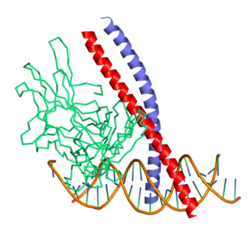Transcription factor Jun is a protein that in humans is encoded by the JUN gene. c-Jun, in combination with protein c-Fos, forms the AP-1 early response transcription factor. It was first identified as the Fos-binding protein p39 and only later rediscovered as the product of the JUN gene. c-jun was the first oncogenic transcription factor discovered.[5] The proto-oncogene c-Jun is the cellular homolog of the viral oncoprotein v-jun (P05411).[6] The viral homolog v-jun was discovered in avian sarcoma virus 17 and was named for ju-nana, the Japanese word for 17.[7] The human JUN encodes a protein that is highly similar to the viral protein, which interacts directly with specific target DNA sequences to regulate gene expression. This gene is intronless and is mapped to 1p32-p31, a chromosomal region involved in both translocations and deletions in human malignancies.[8]
- ^ a b c GRCh38: Ensembl release 89: ENSG00000177606 – Ensembl, May 2017
- ^ a b c GRCm38: Ensembl release 89: ENSMUSG00000052684 – Ensembl, May 2017
- ^ "Human PubMed Reference:". National Center for Biotechnology Information, U.S. National Library of Medicine.
- ^ "Mouse PubMed Reference:". National Center for Biotechnology Information, U.S. National Library of Medicine.
- ^ Vogt PK (June 2002). "Fortuitous convergences: the beginnings of JUN". Nature Reviews. Cancer. 2 (6): 465–9. doi:10.1038/nrc818. PMID 12189388. S2CID 44145552.
- ^ Wisdom R, Johnson RS, Moore C (January 1999). "c-Jun regulates cell cycle progression and apoptosis by distinct mechanisms". The EMBO Journal. 18 (1): 188–97. doi:10.1093/emboj/18.1.188. PMC 1171114. PMID 9878062.
- ^ Maki Y, Bos TJ, Davis C, Starbuck M, Vogt PK (May 1987). "Avian sarcoma virus 17 carries the jun oncogene". Proceedings of the National Academy of Sciences of the United States of America. 84 (9): 2848–52. Bibcode:1987PNAS...84.2848M. doi:10.1073/pnas.84.9.2848. PMC 304757. PMID 3033666.
- ^ "Entrez Gene: JUN jun oncogene".







